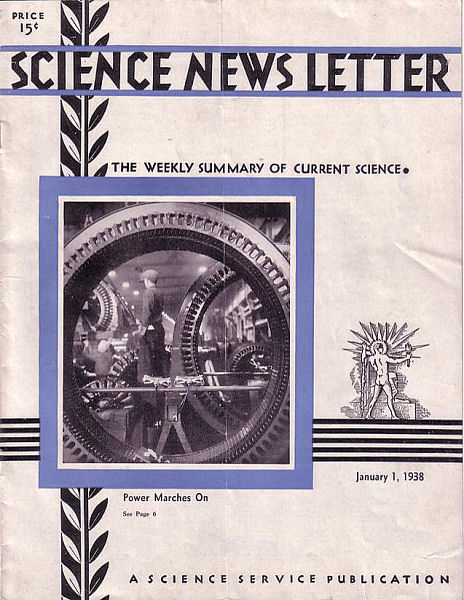From the January 1, 1938, issue

INDUSTRY’S GIANTS ARE INDUSTRY’S CHILDREN
Destined perhaps to be the driving power behind great industrial plants, these beginnings of giant electrical machines are themselves industry’s offspring—giants on the way to birth. Here they are growing in the assembly aisle in the Westinghouse factory. Presently they will be the servants of men; now men are serving them.
NEW “X” PARTICLE SHOULD HAVE NO FIXED MASS
Science may be on the threshold of discovering a whole host of particles intermediate in mass between the electron and the proton nucleus of the hydrogen atom. This is the implication in the report of Prof. G.E.M. Jauncey of Washington University, St. Louis, Mo. (Physical Review).
Under the title “Possible Origin of the X Particle,” Prof. Jauncey describes a new theory which accounts for the newfound particle first discovered at the California Institute of Technology by Drs. Carl Anderson and Seth Neddermeyer and confirmed by the Harvard scientists, Drs. J.C. Street and E.C. Stevenson.
Drs. Street and Stevenson found that the mass of the X particle was about 130 times that of the electron. But, says Prof. Jauncey, there is no special reason why the particle should have this particular mass. Other investigators, in fact, have determined that the particle may have a mass of 700 times that of an electron.
Prof. Jauncey’s theory indicates that the X particle may well be formed in the intricate process of collision occurring when cosmic rays strike the Earth’s atmosphere and scatter atomic “debris” in the form of electrons and photons through the air.
When a photon of radiation strikes an electron in the atmosphere, pictures Prof. Jauncey’s new theory, the photon loses an enormous amount of energy. To create X particles like those observed by Drs. Street and Stevenson, the photon responsible would have to lose energy amounting to 4,306,000,000 volts.
This vast amount of energy is split two ways, suggests Prof. Jauncey. Of this 4,240,500,000 volts go into kinetic energy of moving the X particle, and 66,000,000 volts energy go into increased mass of the X particle. It has previously been found that energy and mass are different forms of the same thing and interchangeable.
The mass energy of an electron at rest, adds Prof. Jauncey, is 500,000 volts, which is about one-130th of the mass of the X particle created, or, said another way, the X particle has a mass 130 times that of the initial electron.
The point is, states Prof. Jauncey, that the X particle created cannot be expected to have any fixed, exact mass by his theory. Its mass depends on the energy in the initial photon of energy which created it. The higher the photon energy the greater the observed mass of the X particle, and there should be, in fact, a whole range of masses for this new particle.
EXPEDITION TO SEEK AGE OF THE PANAMA ISTHMUS
Seeking the birth date of the Isthmus of Panama, which may have been as much as 20 million years ago, two University of Chicago geologists, Drs. Paul C. Miller and Paul O. McGrew, are en route to the province of Gracias, Honduras, where they hope to unearth the desired evidence.
Digging in the tertiary strata of the isthmus, these two geologists, who will later be joined by Everett C. Olsen, a student of fossils, hope to determine just when South American animals were able to walk to North America. Once, before the isthmus existed, this was not possible. If the fossil remains of South American animals can be found and dated in Honduras, the birth date of the isthmus can be determined.







